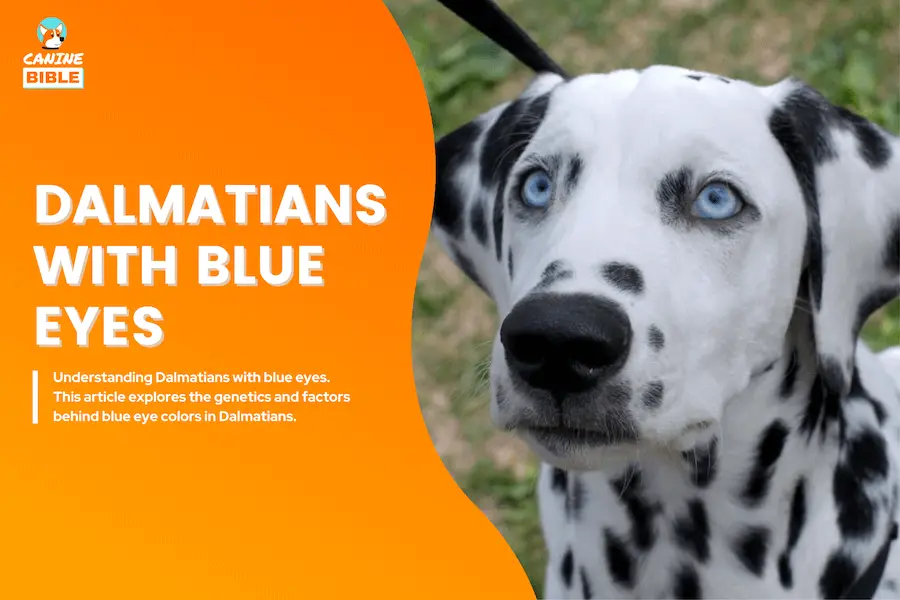Dalmatians With Blue Eyes Guide: The Low Down On This Breed

Canine Bible is reader-supported. We receive affiliate commissions via some of our links. This doesn’t affect rankings. Learn more.
Dalmatian dogs are easily identified by their unique black, liver-spotted coats and regal looks. However, blue-eyed Dalmatians are rare and may sometimes be a warning sign for hearing loss. But why? This guide explains everything you need to know about Dalmatians with blue eyes. Let’s dive in!
History of The Dalmatian
The origin of the Dalmatian dog breed remains a mystery. However, research shows Dals can be traced back to the British Isles, Europe, North Africa, and Asia. Ancient artifacts and paintings resembling the Dalmatian characteristics support this research. One such painting, a fresco from 1360, is held in the Spanish Chapel of Santa Maria Novella in Florence, Italy.
Dalmatians’ original role is uncertain, but it’s believed they were originally bred to be coaching dogs. Dalmatians were used to run along carriages or horseback riders to guard and alert the coachman or rider of the presence of highwaymen. Although the Dalmatians are not from Dalmatia, a southern region in Croatia, the breed gets its name from this region. With the introduction of horse-drawn fire engines back in the 1800s, Dals began their long association with firefighters. The American Kennel Club recognized the Dalmatian in 1888, and the Dalmatian Club of America was formed in 1905.
How Rare Are Blue Eyes in Dalmatians
We surveyed 217 Dalmatian dog parents and found that only 4 out of 217 (or 4 out of 54) Dalmatians had blue eyes. This statistic underscores the unique appeal of blue-eyed individuals within the breed, making them a relatively rare find among their predominantly dark-eyed counterparts.
Reasons Dalmatians Have Blue Eyes
The default eye color for dogs is brown. However, genetics, pigmentation, and health issues can all alter the color of a dog’s eye. These are the main reasons your Dalmatians could develop blue eyes.
The Merle Gene
The Merle gene is responsible for random pigment dilution (whitening) of the nose, eyes, and fur.[1] Dalmatians with the Merle gene are likelier to have blue eyes, but adopting the gene doesn’t guarantee blue eyes in Dalmatians or any dog.
The ALX4 Gene
Scientists at Embark Veterinary, Inc. conducted the most extensive study, where 6,000 dogs’ complete genetic profiles were analyzed. They found that a gene known as ALX4 on canine chromosome 18 is strongly associated with blue eyes.[2]
Albinism
Dogs who lack the genes necessary to produce melanin, the pigment responsible for skin and hair coloring, will be considered albino. The massive loss of pigment through their entire body may also result in a pink nose and blue eyes.
The Link Between Blue Eyes and Health Issues in Dalmatians
Blue eyes in Dalmatians could affect their health and increase the likelihood of major health concerns.
Deafness
According to the University Federation for Animal Welfare and the American Kennel Club, around 30% of Dalmatians are affected by deafness or hearing impairment to some degree. This condition is associated with specific genes, particularly the Merle and Piebald genes. The Merle gene is linked to congenital deafness. In contrast, the Piebald gene, responsible for the distinctive spotting in certain breeds like Bull Terriers, Boxers, English Setters, and Dalmatians, can also contribute to deafness due to a lack of mature melanocytes (melanin-producing cells) in the inner ear.
Dogs should undergo hearing tests, and only those with healthy ears should be considered for breeding. If you’re considering adopting a deaf dog or already own one, learning how to communicate effectively with them is essential. Additionally, using a collar designed for deaf dogs and ensuring they wear a dog ID tag can help keep them safe by alerting others to their condition and reducing the risk of accidents, such as road traffic incidents.
Other Health Problems
Kidney stones, bladder stones, hyperuricemia, and gout are other common health concerns in Dalmatians. These conditions are more prevalent in males than in females.
Regular Health Checks & Care Tips For Blue-Eyed Dalmatians
Care tips for blue-eyed Dalmatians are similar to those for the breed in general. They focus on providing the best food for Dalmatians, plenty of exercise, and mental stimulation to keep them happy and engaged. Routine veterinary visits for vaccinations, parasite control, and overall health assessments are crucial for a long, healthy life.
Dalmatians With Blue Eyes Appearance
What sets Dalmatians with blue eyes apart from their brown-eyed counterpart is their eye color. The Dalmatian is a medium-sized dog with a sleek, athletic-looking body. Males can grow between 19-24 inches tall and 45-70 pounds. Females can be 18-23 inches tall and 45-70 pounds. The tail is relatively long and has a slight upward curve. Dalmatians have a short, shiny coat with distinctive spots as their main unique feature. This breed is intelligent, alert, and highly active, with great endurance.
Dalmatian Temperament & Personality
The first Dalmatians were originally bred to guard horses and coaches, which explains their protective instinct. With proper training, dalmatians can become excellent watchdogs. In general, dalmatians are dignified, smart, and outgoing pets. They have a balanced temperament and are usually well-behaved dogs if appropriately socialized. Their highly energetic and athletic traits make them the perfect furry friend for active pet parents. However, experts say the breed may be too energetic for small children. Dals have great memories and can be sensitive and reserved dogs.
The color of a Dalmatian’s eyes does not affect their behavior or personality. These traits are shaped by genetics, upbringing, and training rather than physical attributes like eye color. Regardless of eye color, Dalmatians are known for their loyal, playful, and energetic disposition. They thrive on companionship and can be strong-willed, making early and consistent training essential.
Dalmatian’s Intelligence
According to this intelligence ranking, dalmatians rank 39th among all dog breeds. According to canine psychologist Stanley Coren, Dalmatians are also ranked as an “above average intelligent” dog breed. They’re the 62nd smartest dog breed out of 138 qualifying breeds for obedience/working intelligence. If you dedicate yourself to training your Dalmatian, they will learn quickly. Dalmatians can learn a brand new command with just 15 to 25 repetitions.
Dalmatian Puppies With Blue Eyes
Dalmatian puppies with blue eyes might melt your heart, but remember some essential tips and precautions before breeding or purchasing one. Firstly, if you’re getting your Dalmatian puppy from a reputable breeder, they should provide you with a record of genetic health testing conducted on the parents and your specific puppy. This information is crucial for understanding your puppy’s potential health risks. It’s important to note that deafness can be prevalent in the Dalmatian breed, particularly among those with blue eyes. Responsible breeders will typically have the entire litter tested to ensure that all the puppies can hear. If this hasn’t been done, it’s reasonable to request it from the breeder.
Dalmatian Puppies With Blue Eyes For Sale
When buying a puppy, be diligent. Make sure this breed fits your personality and your family’s lifestyle. Choose reputable and responsible breeders. The AKC Market Place is an excellent place to start your search and find Dalmatian puppies with blue eyes on sale in your area. When possible, always consider fostering and adopting.
Breeding Dalmatians With Blue Eyes
Breeding blue-eyed dogs is frowned upon or even considered inhumane. But why? When two dogs carrying the Merle gene are bred together, their puppies can be born with a condition known as “double merle,” putting them at higher risk for health problems. While blue-eyed Dalmatians can still have healthy puppies, they frequently produce deaf offspring. However, when a Merle carrier is bred with a non-carrier, the resulting litters typically don’t have any health issues.
Should You Get A Dalmatian With Blue Eyes?
Does a blue-eyed Dalmatian appeal to your liking? Generally, Dalmatians make excellent pets and are great with older kids. Dalmatians are intelligent, active, protective, gentle, and non-aggressive. Improper socialization with dogs and people can lead to behavioral problems. Dals can rise to almost any challenge if properly trained and nurtured. If you are set on getting a Dal pup, internationally renowned animal behaviorist Dr. Ian Dunbar offers the best advice to raise A Happy & Healthy Dalmatian, a must-read for any Dal dog parent.
Owning a Dalmatian with blue eyes comes with extra responsibility, as blue eyes in dogs may increase the likelihood of certain health problems. Prospective owners should seek out reputable breeders who perform necessary health screenings and are transparent about their puppies’ genetics and potential health issues. We can ensure the longevity and happiness of these remarkable dogs through responsible breeding practices. Opting for pet insurance for Dalmatianas is also recommended, mainly due to their propensity to certain health problems.
Like It? Subscribe & Share!
Sources
Canine Bible uses only high-quality sources, including peer-reviewed studies, to support the facts within our articles. Read our editorial process and product review methodology to learn more about how we fact-check, test products, and keep our content accurate, reliable, and trustworthy.
- Why Siberian huskies have those brilliant baby blues. (2018, October 9). Nationalgeographic.com.
- Deane-Coe, P. E., Chu, E. T., Slavney, A., Boyko, A. R., & Sams, A. J. (2018). Direct-to-consumer DNA testing of 6,000 dogs reveals 98.6-kb duplication associated with blue eyes and heterochromia in Siberian Huskies. PLOS Genetics, 14(10), e1007648.








